by Winding Pathways | Dec 14, 2023 | (Sub)Urban Homesteading, Bugs, Garden/Yard, Nature, Pests
Autumn Reveals Nature’s Wonders
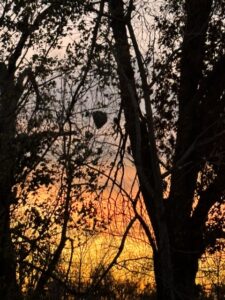
Bare trees reveal a bald-faced hornet nest.
November’s wind stripped the leaves off one of our maples and revealed a big gray football-shaped bald-faced hornet nest. Although we’d walked under it all summer, we had no clue it was there.
This fall many people will discover similar “paper wasp” nests in their trees or shrubs or even tucked near a light fixture. Made of a paper-like material, the nest was really made by insects called “bald-faced hornets” that are related to other wasps, including yellow jackets.
These social wasps can attack in droves. Their sting hurts. Because their stingers are smooth, unlike honey bees, they can sting again and again.
So, what do you do when you spot a nest on a crisp fall afternoon? Leave it alone!
Life History
The insect’s life history gives the best clue on how to avoid painful stings.
Last fall the colony of 500, or so, worker wasps died as the weather cooled. The fertile queen survived by tucking herself under a rotting log somewhere to slumber through winter. Come spring she’ll make a tiny paper-like nest, usually in a tree, and lay eggs that become workers. These hard-working new insects expand the nest and forage widely.
They are omnivores eager to dine on rotting fruit, but among their favorite foods are caterpillars and adult insects. Bald-faced hornets are a gardener’s friend, removing vegetable-chomping insects. They also sip on nectar so are good pollinators.
Aggressive or Protective?
Most sources claim they are highly aggressive, and they are if someone disturbs their nest. Several years ago, an adult neighbor spotted a nest above the doorway that the family had used all summer. He tried to knock it down and only damaged the nest. His misguided aggression unleashed an attack by dozens of upset bald-faced hornets. Stung many times, he’ll likely never again molest a nest.
We walked under and near the bald-faced hornet’s nest in our yard many times this summer and didn’t even know it was there. They didn’t attack us. Rather, they snacked on our vegetable gardens’ pests.
The lesson: leave these insects and their nest alone.
Ironically, by the time most people discover a nest in very late fall, the colony has already abandoned it. The best thing to do is NOTHING. Winter’s wind, rain, and snow will disintegrate the nest, and the queen will find a new spot to build next year’s colony.
by Winding Pathways | Dec 7, 2023 | (Sub)Urban Homesteading, Birds, Nature
Why do Birds Fly Into Windows?
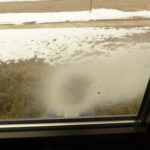
The spray makes the window opaque.
Windows, deadly for birds. According to the National Audubon Society, about one billion birds are killed every year when they crash into windows. About half collide with low commercial building windows with the rest crashing into home windows. Surprisingly few seem to crash into the high windows of skyscrapers.
Birds fly into windows because they just don’t see them and assume they’re about to zip through safe soft air. Sometimes they may see reflections of vegetation behind them and think they are zooming to a convenient perch.
How to Help a Bird
When Rich was director of the Indian Creek Nature Center, he’d often get calls from upset people who had just found a quivering bird beneath their window. In his experience one of two outcomes is likely. Either the bird will soon die or it will fully recover and fly off. He suggests leaving the bird alone for at least an hour unless it’s likely to fall prey to a hungry neighborhood cat. In that case, it is probably best to gently place it in a cardboard box to give it a chance to recover…or die.
Unfortunately, there’s no effective first-aid technique to reverse death. Hopefully, the bird will soon recover and speed away. If not, a respectful burial is in order.
Tips
Here are some tips from the Portland, Oregon, Audubon Chapter of the National Audubon Society for reducing window collisions:
- Place bird feeders away from large windows.
- Avoid putting house plants immediately inside windows. Birds may see them and attempt to fly to a perch.
- Put stickers/decals on the outside of windows. (Note: Many sources recommend these. Stickers can be bought online or at bird-feeding stores……but we, at Winding Pathways, have not found them very effective.
- Stretch netting across the outside of the window to physically keep birds from crashing. We’ve found this best on windows that experience frequent bird collisions.
- Put colorful tape on the outside of the windows.
- Douse outside lights. Come sundown our nation is way over-lit. Lights block viewing the magnificent night sky while often disorienting migrating birds.
We Can Help
Songbirds face many challenges in our modern world. They crash into windows, hit poles, get gobbled up by house cats, and are confused by electric lights. They need all the human help they can get to stay alive and healthy.
by Winding Pathways | Nov 30, 2023 | (Sub)Urban Homesteading, Garden/Yard
On Fire?
Many readers know we burn our yard. What? Are we nuts? Fire kills. Fire destroys. Well, it can but it also cleanses and heals.
It’s one way to manage natural growth on properties. So, on a balmy early November day, we set our yard on fire! Flames towered over the yard as intense heat pushed outward.
We usually burn smallish prairies we’ve planted in both our front and back yards. Years ago, we usually burned in March but more recently we’ve shifted to November. Burning in fall seems to encourage wildflower blooms next summer.
Preparation is the Key
We’re unusual but not reckless. (A good read is at this address. www.prairienursery.com/media/pdf/burn-your-prairie-safely.pdf.) Before burning we did these things:
- Mowed a wide firebreak around our proposed burn area. Closely clipped lawns are nearly as effective as a firebreak as pavement or bare soil.
- Acquired a fire permit from Linn County Public Health.
- Found friends and neighbors to help us manage the burn.
- Ahead of time educated neighbors about the value of burning and then alerted them of our plan to burn in a certain time frame.
- Had appropriate tools on hand before we burned. These included garden rakes, matches, and both a portable fire pump, called a “Smith Indian”, and a hose stretched to the burn site.
-
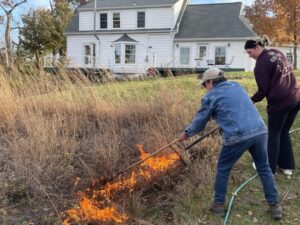
-
Workers spread flames.
-
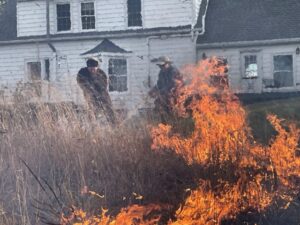
-
Working together.
Important Last-Minute Steps
On the day of our proposed burn, we did what the Health Department requires and first checked the air pollution report. We are only allowed to burn when the air quality is good, so jump online to a local map that shows real-time air quality. If the air quality is good, we call the sheriff’s department before burning. This is so that if someone reports smoke or fire, they know not to send out firefighters.
A light breeze helps push the fire through standing dried-out prairie grass, but too much wind can be dangerous. Our permit allows us to burn only if the wind is 20 mph or less.
Consideration of Neighbors
Because busy 30th Street Drive is our south property border we burn only when a south wind will push smoke away from the road and neighbor’s homes. North of our property is a large woodland where no one lives and there’s plenty of space for the smoke to disperse.
Rewards After Burning
Burning takes planning and preparation but the actual burn is over in a flash. On November 5th we were all ready, called the sheriff, and lit the prairie just after 3 pm. Flames roared through the grass and stopped dead when they reached our mowed lawn. Less than an hour after striking the match our fire was completely out and we were munching on pizza.
Most homeowners can’t burn, but many can. It’s an interesting and natural way to manage property. And, it’s fun.
by Winding Pathways | Nov 9, 2023 | (Sub)Urban Homesteading, Mammals, Nature
Update on Furless Tailed Squirrels
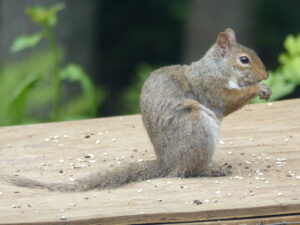
Even in winter, the squirrels’ fur looks healthy…except for their tails.
Two winters ago, we noticed squirrels with nearly furless tails visiting our bird feeders. Our blog about them on Winding Pathways brought hundreds of visitors. Some from other countries! Apparently, we weren’t the only people seeing these hapless animals.
Last winter we had almost no squirrels in the yard. We wonder if the malady that caused them to lose tail fur might have knocked their population way back.
This fall we’re seeing plenty of both fox and gray squirrels in our yard. Their populations have rebounded. And, they have long, furry tails! Squirrels make us happy. While many people don’t like them gobbling seeds at the feeder, we are OK with that and find them as fascinating and fun as cardinals, chickadees, and goldfinches.
Squirrels and the Derecho
Now three years since the disastrous derecho that felled thousands of trees in the Eastern Iowa area, we’re seeing the vital work squirrels do. In the wake of the storm, people planted thousands of trees. Then came three drought years. The National Weather Service placed Cedar Rapids into its exceptional drought category in 2023.
The drought killed many human-planted trees but the ones planted by squirrels are doing just fine. Thanks to them, baby hickories, walnuts, and oaks are poking through the soil in nearby woodlands and our yard.
This fall we’ve watched squirrels carry acorns and walnuts across the yard, dig frantically, and bury their treasure. These enthusiastic gatherers and diggers plan to return during winter’s lean months to retrieve dinner from underground storage. Fortunately, squirrels bury more nuts than they’ll ever need. Unfortunately for them, some of the furry hoarders die with their hidden hoard untouched to sprout in the spring. Squirrels are master tree planters.
-
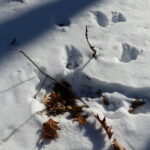
-
Squirrels at work.
-
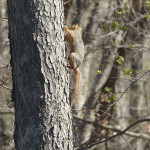
-
What happens when a squirrel falls?
-
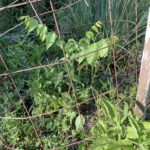
-
This squirrel planted walnut seedling sprouted just this year in spite of the drought.
American Ninjas in the Yard
An oak and a walnut live about 150 feet south of our back deck. Acorns and walnuts are epicurean squirrel delights, and our trees attract the furry acrobats. Squirrels like to use treetops as highways, jumping from one to the next. Our oak and walnut presented them with a problem. There is a several-foot gap between their branch tips. We are fascinated watching the squirrels make the long leap from twig to twig, sometimes leaping up to reach a branch on another tree, often while clutching a nut in its teeth. Their athleticism is astounding. So is their courage.
Squirrels fall. Twice we’ve seen one lose its grip and drop from the top of enormous trees. Both times the furry animals spread eagle their legs and tails while descending and hit the ground with a thump. They are shaken, rest, and then scamper off. A fall that would instantly kill a person, is hardly phased by the squirrels.
This winter we’ll again welcome squirrels to our feeders. They can dine on whole or cracked corn and cobs. We are assured of entertainment with their romps, athleticism and enthusiasm.
-
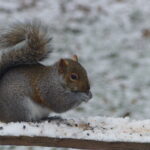
-
Squirrel tails have many uses.
-
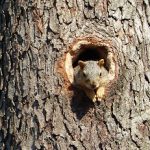
-
It’s a long way down, Mom.
-
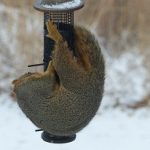
-
Squirrels wolf down seed meant for birds.
by Winding Pathways | Oct 26, 2023 | (Sub)Urban Homesteading, Garden/Yard, Nature, Trees
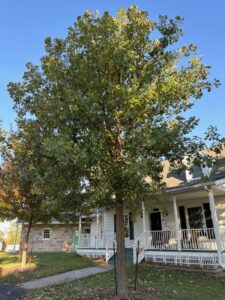
Magnet bur oak in front yard
We didn’t intend to create a magnet when we planted a skinny bur oak in our front yard 13 years ago.
It created a startling experience one October evening when Marion went to the porch to check the weather. A large furry form dropped from the nearby tree and scurried away in the gathering darkness. A woodchuck? Not likely. They work the day shift. Later we caught the mystery animal in the bean of a flashlight as it returned to the magnet tree. A husky raccoon that again retreated in haste when it saw us.
Over the next several days we watched squirrels and woodchucks forage on the acorns. At dusk bucks and does with yearlings eagerly, yet watchfully, gobbled up acorns. In between, turkeys wandered by to forage. Blue jays dropped out of the tree onto the ground and carried off husky acorns to store for winter.
Why Oaks Attract Wildlife
Our October oak was a perfect magnet. While most area oaks were acorn-bare, our youthful front yard tree was loaded with them. They were huge, sweet, and free of the weevils that often consume acorns before exiting through tiny holes.
Blue jays, wild turkeys, woodchucks, raccoons, squirrels, and deer consider October acorns prime carbohydrate-loaded food. When few oaks, scattered around, bear a heavy crop, wild animals beeline to those loaded with nuts. That’s why our tree was a magnet drawing in a stream of wildlife until every acorn was consumed.
-
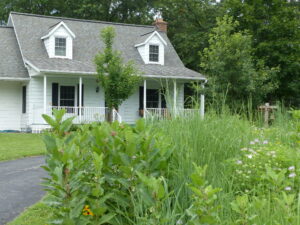
-
Small oak and maple.
-
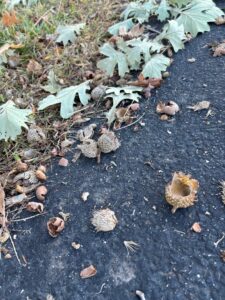
-
Prolific Bur Oak acorns
-
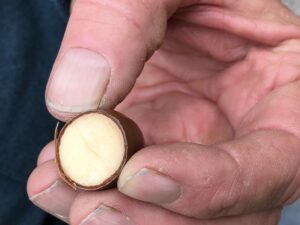
-
White oak acorns have lower tannic acid.
White oak types have leaves with rounded lobes. These include white, bur, and swamp white oaks. Their big acorns are low in tannic acid and are a prized animal and human food. Most trees only bear a heavy crop every few years with acorns that sprout almost as soon as they hit the ground. If not eaten soon weevils find them.
Black oak types have leaves with pointed lobes. Their acorns are loaded with bitter tannin. Often wild animals only feast on them after nearby sweeter white oak-type acorns have all been eaten. Black oak-type acorns wait until next spring to sprout. Perhaps their tannic acid helps them remain uneaten until they sprout months after falling from the tree.
Optimal Places to Plant Oaks
When planted in an ideal location with full sun and rich soil, an oak will begin producing acorns when it’s seven to ten years old. Our front yard tree had a light crop the past few years, but when it reached its 13th year it was loaded with nuts. It was a true magnet that lured wildlife in from far and wide. We enjoyed watching many animals dine on acorns produced by a tree we planted.
by Winding Pathways | Oct 12, 2023 | (Sub)Urban Homesteading, Preparedness
What To Do When No Room At the Inn?
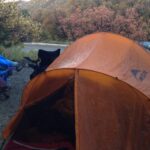
Even bivouac camping can be comfortable.
Basic bivouac camping gear saved our night as we drove along a rainy Ohio Interstate.
We were returning to Iowa from a business trip in New Jersey. The 1000-mile trip is too far for us to make in a day so we normally plan to overnight in a comfortable motel in Ohio or Indiana.
On this recent trip, we didn’t make a reservation in advance, so Marion called motels ahead of us as Rich drove through pelting rain. Bad news. They were all booked for the night.
Bivouac Camping Saved Us!
Our basic bivouac camping gear saved us. Marion spotted West Branch State Park on the map. Not far ahead of us and near the Interstate, we exited just as the downpour subsided. Soon we enjoyed a hot dinner inside a restaurant near our tent.
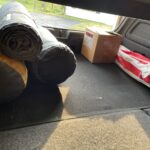
Lightweight camping gear stashed on the sides of the car.
Although we weren’t on a camping trip, we always carry basic bivouac camping gear just in case we run into a situation like our recent one. Modern backpacking gear is lightweight, compact, and effective. It’s essential for a long trail trek but also takes up little space in the car and comes in handy should camping be necessary.
Here’s what we always slip into the car:
- Small nylon tent and ground cloth. Sturdy pegs (spikes or gutter nails are sturdy, don’t bend and so are useful to hold cords to tie a tent down.)
- Lightweight foam mattresses and sleeping bags.
- Folding chairs.
- Cooking and food gear that includes:
* Tiny featherweight butane stove and fuel bottle
* A few backpacking-type meals
* Basic utensils
* Matches! (Remember these!)
Cooking gear and dried meals fit in a small cardboard box and it’s easy to stash the other gear here and there in the car.
-
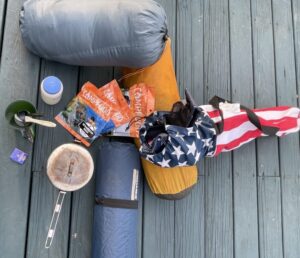
-
Looks like a lot! It’s not!
-
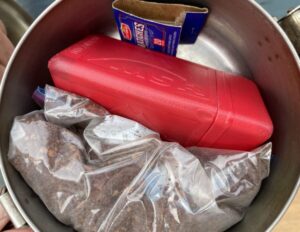
-
Essentials in box
The morning after our unplanned campout we woke well-rested, sipped instant coffee, packed up, found a breakfast cafe, and were soon back on the Interstate heading home.
A Note on Dried Food
Years ago, dried camping food was tolerable but hardly tasty. That’s changed. Modern foods are delicious. We keep two weeks of dried meals in our preparedness bin at home. Should we be impacted by a natural disaster we’d break out our camping stove and enjoy tasty meals. Although this food lasts for years we occasionally eat a few meals at home, on planned camping trips, and during emergencies. Then we restock with fresh meals. We have previously written about preparedness on our blogs.



















